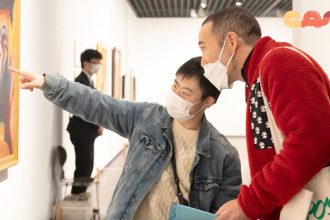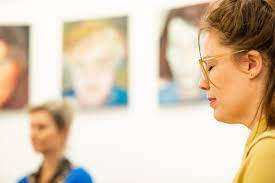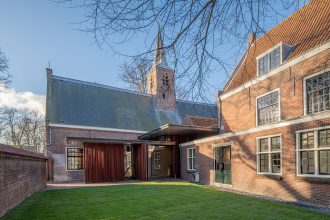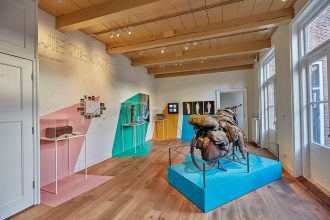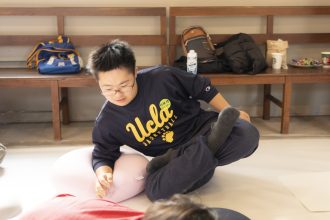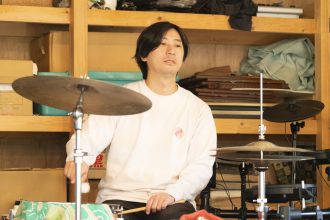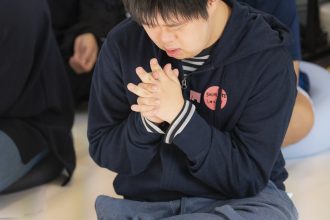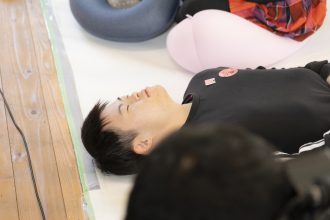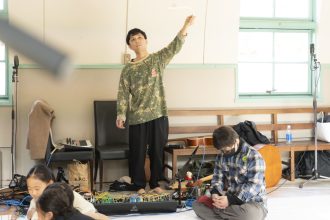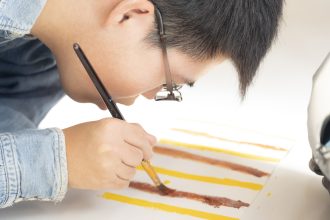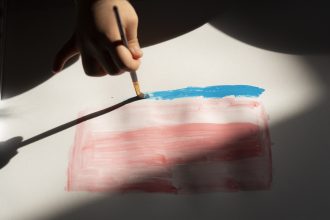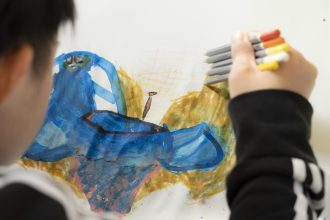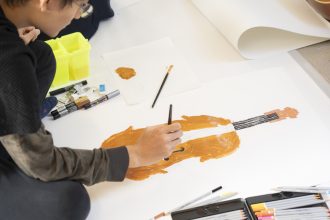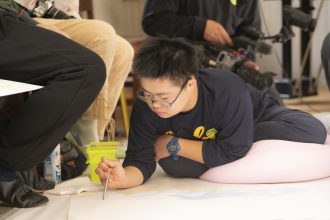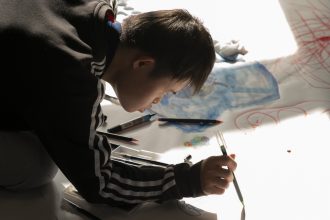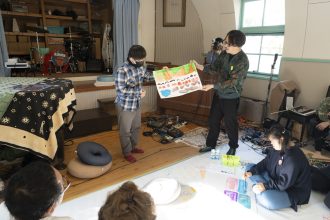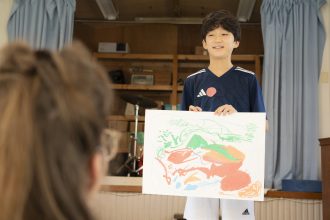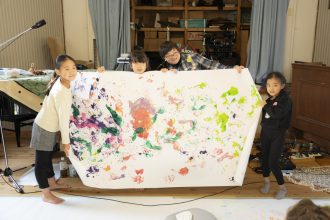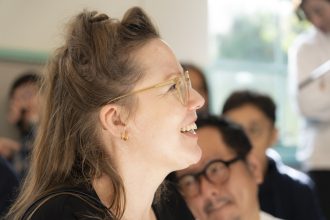Report by Keiko Kamijo on the music and mental health workshop “Mark Through the Music” organized by Collective Amazement Troupe [CAT].
Immersed in Sound, Light, and Warmth: A Journey Toward New Creative Horizons
The Museum of the Mind in the Netherlands, bridging the boundaries between healthcare, art, and science, has partnered with atelier A in Japan—a supportive art class for children with Down syndrome and autism—and AIT to kickstart the “Collective Amazements Troupe (CAT)” program. This pioneering project brings together children with diverse characteristics and their guardians on a voyage of discovery, driven by mutual curiosity, co-creating spaces where artistry can flourish. Since its inception in 2022, CAT has been a nurturing ground, fostering meaningful connections among its participants. On December 16, 2023, they unveiled the “Mark to the Music” workshop, marrying music with meditation to spark creativity.
Developed as part of the “Music and Mind Inspiration Program” by CAT, this workshop aims to infuse a touch of magic—“inspiration”— into their everyday engagements, carving out new paths for artistic exploration.
As part of this initiative, CAT has been organizing “Inspiration Tours” for members of aAtelier A, who regularly convene at the Yoyogi-Uehara Community Education Center, accompanied by facilitators. These tours, which traverse art museums in and around Tokyo, aim to go beyond mere appreciation of art by evaluating the impact of these cultural experiences on the regular creative activities at aAtelier A. The subject matter often explored by aAtelier A members reflects the rich tapestry of their daily lives, encompassing activities with family, meals, favored YouTube videos and TV shows, and beloved characters. Following the ‘Inspiration Tours,’ a diverse range of creative outputs emerged at aAtelier A, from works deeply influenced by the tours to those that remained consistent with the members’ usual artistic endeavors, demonstrating the varied impact of the tours. Moreover, the collaboration between the Museum of the Mind and aAtelier A has facilitated valuable discussion sessions under the CAT initiative. These sessions aim to deepen the dialogue by sharing insights from the “Inspiration Tours,” fostering a stronger connection and exchange among all participants.
This event was further enhanced by the presence of Jolien Posthumus, a researcher from the Museum of the Mind in the Netherlands, whose visit made possible the realization of the “Mark to the Music” workshop, an inventive blend of music and meditation, with CAT members.
The Instructor’s Expertise: “Art and Mindfulness”
Let’s take a moment to introduce Jolien Posthumus, our workshop instructor. She holds the role of mindfulness trainer and mental health program manager at the Museum of the Mind. Posthumus, having navigated PTSD from early life experiences, found solace and a means of self-expression in singing and dancing on stage. “Art has truly been a healing force in my life,” Posthumus reflects. From her days as a student, she has enriched her understanding of art history, cultural history, Buddhism, meditation, and bodywork, actively integrating these insights into her life and work. In addition to her contributions to art and culture museums, she has also taught mindfulness at the Body College, where she offers guidance to individuals grappling with mental health issues.
Since around 2017, Europe has increasingly recognized mental health as a critical social issue. This recognition has led to a surge in demand for Posthumus’s unique blend of skills in “Art” and “Mindfulness,” particularly from cultural entities like museums. The World Health Organization (WHO) has also highlighted the symbiotic relationship between art and health. Their November 2019 report, “What is the evidence on the role of the arts in improving health and well-being? A scoping review,” underscores how art, in its many forms, contributes to well-being through both active and passive engagement. Posthumus’s journey of integrating “Art” with “Mental Health Care” addresses an increasing societal need.
The Museum of the Mind features two distinct locations in Amsterdam and Haarlem. The Haarlem site, housed in a building that once served as a mental hospital, is notable for its historical significance and the legacy of societal exclusion and confinement of patients with mental disorders and leprosy. Founded in 2002 by four Dutch psychiatric care organizations (GGZ Noord-Holland-Noord, GGZ inGeest, Arkin, and Parnassia Group), the Haarlem museum seeks to challenge and transform the stigmas associated with its past and revisit society’s understanding of mental illness. 
These institutions not only offer financial backing to the museum but also enhance its collection with their historical archives. The museums are proactive in their educational missions, aiming to shed light on mental and physical health and challenge existing biases about mental illness. Through active outreach, they collaborate with healthcare workers, museum professionals, and educational bodies. They roll out initiatives such as ‘Learn more about mind,’ which delves into the intricacies of our mental and physical selves, and ‘Word Up,’ a dialogue-driven program designed to engage young adults in meaningful conversations about mental health. This holistic approach underscores their commitment to addressing the multifaceted nature of psychological and physical well-being.
The “Music and Mind” Workshop: Starting at Last!
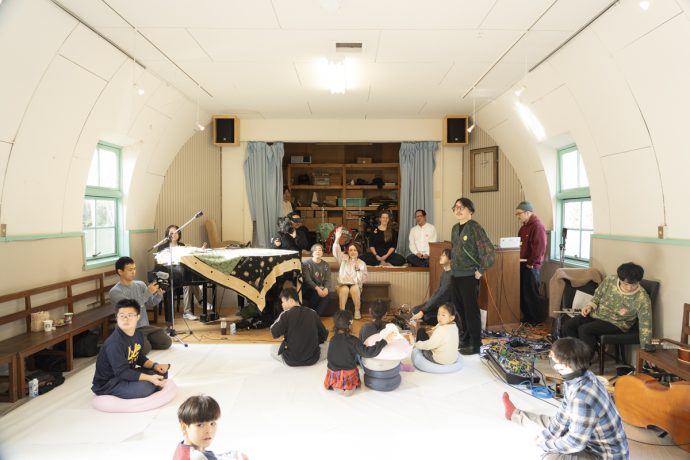 The “Mark to the Music” program, blending music with meditation, first took place at the Amsterdam Dance Event (ADE) in 2017, one of the city’s premier music festivals. Under Posthumus’s guidance, participants immersed themselves in ambient music, encouraged to express themselves freely.
The “Mark to the Music” program, blending music with meditation, first took place at the Amsterdam Dance Event (ADE) in 2017, one of the city’s premier music festivals. Under Posthumus’s guidance, participants immersed themselves in ambient music, encouraged to express themselves freely.
Inspired by this, AIT, atelier A, and the Museum of the Mind jointly conceived the workshop. Featuring four renowned musicians—Hiroshi Takano, Koryo Saito, Tetsuro Yasunaga, and Yorimasa Fujimura—the workshop offered a live performance of ambient music, thereby enriching the artistic voyage for atelier A’s participants. The venue, the historically rich ‘Kamaboko Barracks’ nestled within the premises of a Catholic church in Setagaya, Tokyo—a post-war relic vacated by the U.S. military—provided a poignant backdrop.
The day of the event was caressed by sunlight, with the winter’s rays streaming through the unique kamaboko-shaped ceiling, bathing the space in a warm, inviting light. The floor was laid with paper for drawing and lounging, dotted with colorful pastel bead cushions, creating a welcoming atmosphere for all.
With the introductions behind us, the workshop officially commenced. With the onset of tranquil music, Posthumus extended a gentle invitation: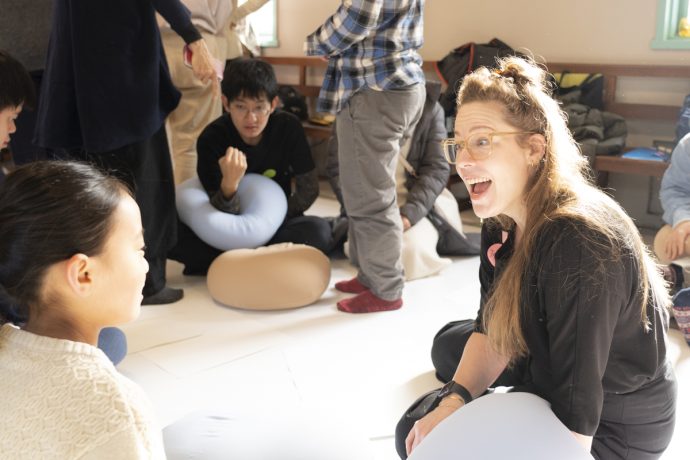 “If you feel more at peace with your eyes closed, please do so. Let’s all tune into the sounds filling the room.”
“If you feel more at peace with your eyes closed, please do so. Let’s all tune into the sounds filling the room.”
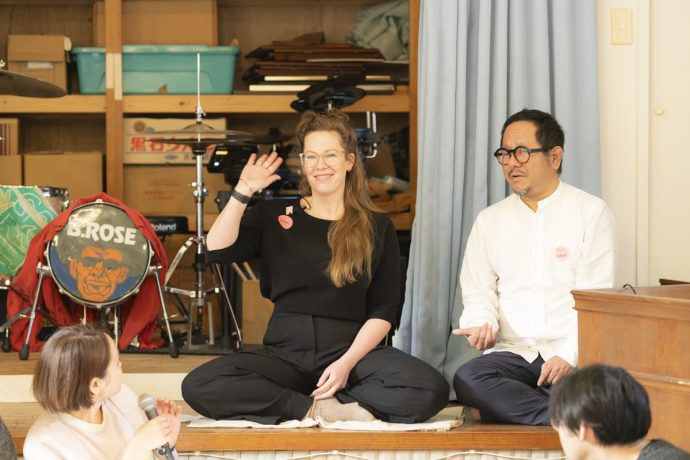
Imbued with Sound and Light: Capturing the Essence Unique to This Moment and Space.

The children, initially mesmerized by the instruments, began to close their eyes, though some chose to keep theirs open. While some lay sprawled on the floor, others gently caressed the bead cushions, a few adopted postures of prayer, and some couldn’t resist yawning—each engaging with the music in their own unique way.
“Feel the music as it slowly changes, and firmly acknowledge your presence here, right now.”
“Listen with your ears, but also try to feel the music in your stomach or deep inside you.”
“What are you feeling as you listen to the music? It’s okay to move your body along with the music.”
“If you could choose a color for your feelings, which one would it be? Feel free to paint with the color you’re feeling.”
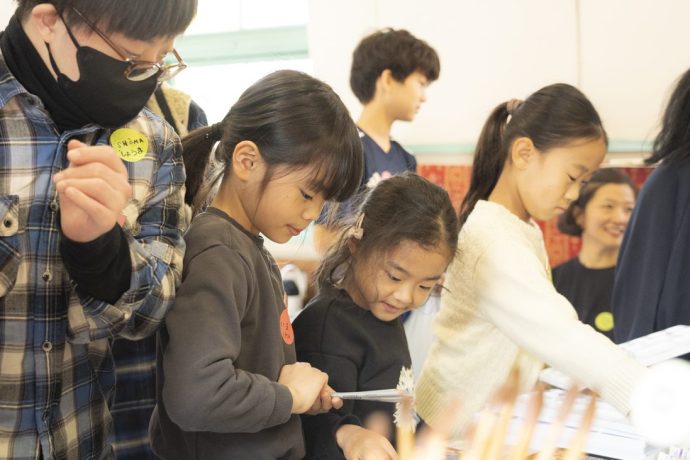 Posthumus, as the music continued, spoke to the participants in a soft, unhurried manner. As time passed, the music’s character gently transformed, blossoming into a more lively sound with a bell-like rhythm. Prompted by Posthumus’s encouragement to “draw what you feel,” the children sprang into action, grasping drawing materials and letting colors and lines flow freely across the floor.
Posthumus, as the music continued, spoke to the participants in a soft, unhurried manner. As time passed, the music’s character gently transformed, blossoming into a more lively sound with a bell-like rhythm. Prompted by Posthumus’s encouragement to “draw what you feel,” the children sprang into action, grasping drawing materials and letting colors and lines flow freely across the floor.
Some drew in silence, focusing on continuous lines, while others depicted sequences of fine lines. There were also those who illustrated objects resembling yachts floating on the sea, as well as rainbows, skies, and fluffy, abstract images.
All participants on site inspire each other.
“When I listened to the music, I thought of light blue, like the peaceful waves in the morning.”
“The cello was so beautiful that I could not help but draw it as I listened to the music.”
As the workshop drew to a close, the music shifted to a more upbeat and lively rhythm. This change seemed to lift the spirits of some children who, feeling the vibe, took off their shoes to dance and paint on the large paper spread on the floor. 
While some children moved with the music as if to react to its changes, others stayed deeply immersed in their artwork, seemingly oblivious to the surrounding sounds and activities.
Akaogi’s voice signaled, “Time to share,” bringing the creative process to a pause. Now, it was time for each child to present their day’s work to the group, following the usual practice at atelier A.
Each child took turns explaining their artwork to Posthumus, sharing the inspiration behind their drawings, the emotions they felt throughout the process, and how the musical shifts impacted their creations. Not all feelings could be captured in words, yet Posthumus attentively absorbed every detail. She connected with each piece of art empathetically and patiently, seeking to understand the deeper messages and emotions conveyed.
Though the time was limited, it was a profound communal experience, where the act of sharing artwork and simply being together made everything feel extraordinary. Opting for live, improvisational music over prerecorded tracks introduced an additional layer of spontaneity. The musicians—presumably working within a pre-determined rough structure—adapted their performance dynamically, attuned to the children’s responses and emotions, fostering an interactive space where each presence contributed to the creation of a magical environment.
Text:Keiko Kamijo Photo:Isamu Sakamoto
“It was like being bathed in a dreamlike light that reflected from one person to another, eventually inspiring the colors they brought to life on paper. Witnessing our music evolve into colors and merge into a greater light was deeply comforting.”
Koryo Saito / Musician“Every sound—from the instruments, the rustling of paper underfoot, to someone's breathing or laughter—was equally perceptible. Unheard sounds became clear, giving rise to unique creations. It was a day where everyone was both a creator and part of the collective environment, fully enjoying the space's emerging richness.”
Tetsuro Yasunaga / atelier A Staff“My child, who is usually tense, found freedom and joy in drawing thanks to the soothing music, comfy cushions, and Jolien's gentle guidance. Each child relaxed in their own way, inspired by the ambiance and the music.”
Parent of an atelier A Member“I was amazed at how well meditation and music suited the children, challenging my assumption that these were adult-only activities.”
Parent of an atelier A Member“My daughter shockingly claimed she 'didn't listen to the music!' But one musician was pleased, saying, 'I'm happy if she was so engrossed in drawing that she didn't hear the music.' However, I feel the music indirectly influenced something in her.”
Parent of an atelier A Member“The children seemed to listen to Jolien earnestly and tried their best to respond. Their effort to empathize and understand touched me.”
Parent of an atelier A Member“Initially, I thought meditation and ambient music might be too advanced for children, but seeing them surpass my adult assumptions was a lesson for me as well.”
Parent of an atelier A Member“As the music played softly, the children were relaxed from the start. Following Jolien's gentle prompts to meditate, they naturally focused and enjoyed themselves, resulting in beautiful creations. I was amazed to see such expressions and reactions emerge from the children. It was an unprecedented, wonderful workshop experience.”
Hisae Maeda / Illustrator, atelier A StaffSeeing the drawings spill from the paper onto the floor and even on stones made me realize how much the act of drawing is usually confined to the boundaries of a square piece of paper. Furthermore, during the presentation, one of the participants explained that he had drawn “the tree of all beginnings,” which reminded me of the intricate paintings from the Mughal era in India, where trees are often depicted as the source of life. This made me wonder if the children were intuitively sensing the flow of life through the vibrations of sound, sparking all sorts of imaginative thoughts.
Yosuke Yamaguchi / Illustrator, atelier A StaffI was initially worried whether 7-year-olds could engage with ambient music and meditation. However, seeing the children relax and start drawing freely with the music and meditation deeply moved me. It made me reflect on how I might have imposed my own adult notions of what being childlike means or unnecessarily set limits. This has been a significant learning experience for me as an adult. Seeing them paint so freely with their feet by the end, it was clear that the conversations with the adults had a significant impact on them. Thank you so much. I would be delighted to have the opportunity for new challenges like this again.
Erika Kobayashi, Manga Artist, Writer, atelier A Staff“Implementing this program at the Museum of the Mind was familiar, but creating it as a team was a novel experience. Initially nervous, the collaboration with incredible musicians and the reliable AIT team turned out wonderfully. Engaging with art, both in viewing and creating, transcends language, offering a profound way to see and listen to others deeply.”
Jolien Posthumus / Museum of the Mind“Just as I imagined, it was an incredibly free and wonderful event, leaving me at a loss for immediate words. Translating sound into art seems challenging even to me, but seeing everyone so brightly engaged and earnestly attempting to express themselves convinced me of the event's success. Observing them in a different light than usual was truly rewarding. Witnessing their expressions made me realize the importance of venturing into new places and the value of communication in varied settings.”
Tetsu Akaogi / Director of atelier AGuest Musician : Hiroshi Takano, Koryo Saito, Yorimasa Fujimura, Tetsuro Yasunaga
DJ : Taro Nettleton
Facilitator:Taku Yokosuka, Yoko Akaogi, Yosuke Yamaguchi, Mashu Oki, Saki Kato, Lhotse
Interpreter(Japanese-English) : Satoshi Ikeda
Photographer : Isamu Sakamoto
Videographer : Yasuyuki Fujii, Takuya Takeuchi
Support: Ryota Nagai (Roland)
Special Thanks:Fumiyo Kishibe, Hideo Matsukiyo, Fumiko Hosogai
All the children and staff of atelier A, and everyone who helped us.
Planning and Production: Naoko Horiuchi, Rika Fujii(dear Me Project by AIT)
Production support: Marina Yamaguchi, Mafumi Wada, Rie Okuma(AIT)
Venue: Shimokitazawa
Guest: Jolien Posthumus from the Museum of the Mind
Musicians: Hiroshi Takano, Koryo Saito, Tetsuro Yasunaga, Yorimasa Fujimura
Participants: Children and youths with Down syndrome and autism (invited by atelier A)
*Note: This event was held privately and was not open to the general public.
Organized by: The Agency for Cultural Affairs, Nonprofit Organization Arts Initiative Tokyo [AIT]
Planned and Operated by: dear Me Project by AIT
In Collaboration with: atelier A, Museum of the Mind
Support: Shiseido Camellia Fund, Embassy of the Kingdom of the Netherlands
Sponsors: Roland Corporation, Liquitex., MOGU Inc.
Fiscal Year 2023: “Cultural and Artistic Activities Promotion Project for People with Disabilities”
An Inspiration Program in Art and Mind, Experiencing Wonder Together
-
Keiko KamijoFreelance Editor. Works in editing and writing for magazines and books and has been involved in the activities of atelier A as a staff member since around 2013.


